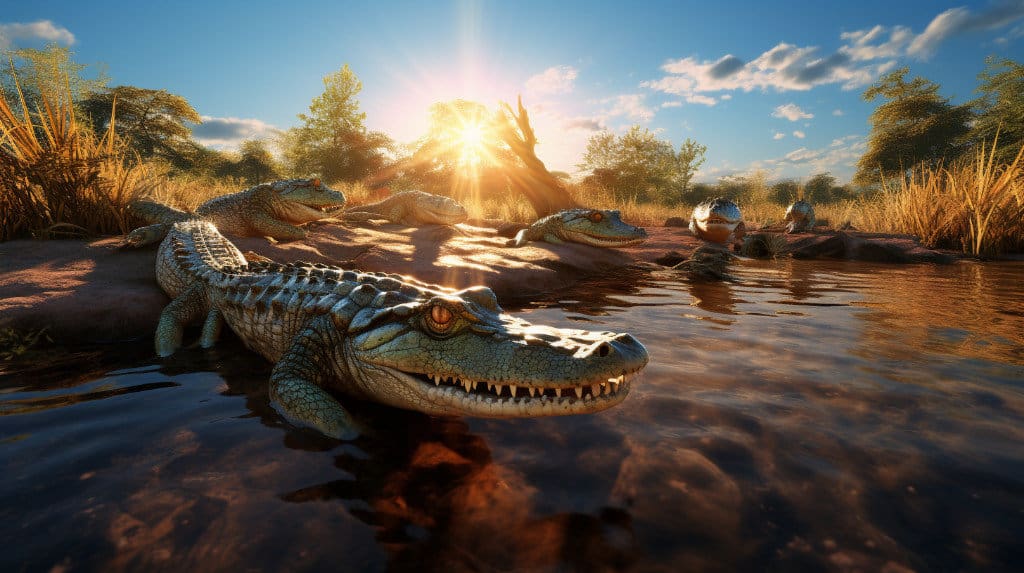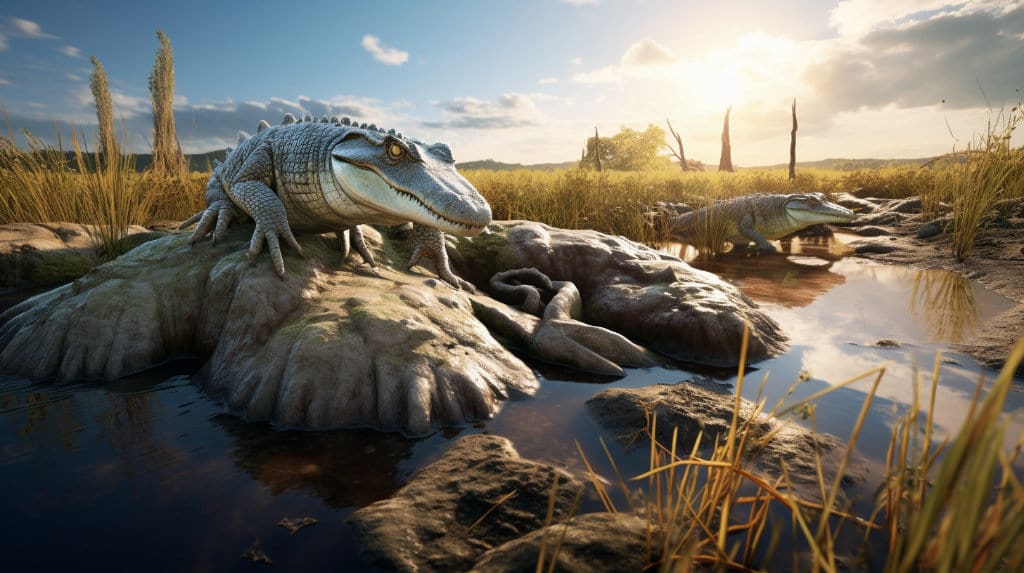Crocodiles are fascinating creatures that have captured the imagination of people for centuries. One of the most intriguing aspects of crocodiles is their unique physiology, particularly their body temperature regulation. Crocodiles are indeed cold-blooded animals, which means that their internal body temperature is dependent on the temperature of their surroundings. This allows them to adapt to various environments and thrive in both warm and cold climates. To understand more about crocodiles and their cold-blooded nature, let’s take a look at some key takeaways:
Key Takeaways
| Fact | Description |
|---|---|
| Body Temperature | Crocodiles are cold-blooded, meaning their body temperature fluctuates with the environment. |
| Sunbathing | Crocodiles bask in the sun to raise their body temperature and increase their metabolism. |
| Water Regulation | They can regulate their body temperature by moving between water and land. |
| Metabolic Rate | Being cold-blooded, crocodiles have a slower metabolic rate compared to warm-blooded animals. |
| Adaptability | Their cold-blooded nature allows crocodiles to survive in a wide range of habitats. |
This concise table provides some factual information about crocodiles being cold-blooded and highlights key aspects of their unique physiology.
Understanding Cold-Blooded Animals
Cold-blooded animals, also known as ectothermic organisms, are fascinating creatures that rely on external sources of heat to regulate their body temperature. Unlike warm-blooded animals, such as mammals and birds, cold-blooded animals cannot generate their own body heat. Instead, they adapt to the temperature of their environment, which greatly influences their behavior, physiology, and habitat.
Definition and Characteristics of Cold-Blooded Animals
Cold-blooded animals, also referred to as poikilothermic animals, have a body temperature that fluctuates with the temperature of their surroundings. This means that their internal body temperature is not regulated internally but rather by the external environment. As a result, their body temperature can vary significantly throughout the day and in different seasons.
Reptiles, including crocodiles, snakes, and lizards, are prime examples of cold-blooded animals. These creatures have evolved unique physiological and behavioral adaptations to survive in diverse environments. For instance, crocodiles are known for their remarkable temperature regulation abilities. They can bask in the sun to raise their body temperature or seek shade to cool down. This flexibility allows them to thrive in various habitats, from tropical rainforests to arid deserts.
Examples of Cold-Blooded Animals
Let’s take a closer look at some fascinating examples of cold-blooded animals:
-
Crocodiles: These ancient reptiles are renowned for their impressive size and strength. They are well-adapted to aquatic environments and can be found in rivers, lakes, and swamps. Crocodiles are known for their stealthy hunting techniques and powerful jaws, which they use to capture their prey.
-
Snakes: Snakes are incredibly diverse and can be found in a wide range of habitats worldwide. From venomous cobras to non-venomous pythons, snakes have evolved various strategies for survival. They use their forked tongues to “smell” the air and detect prey, and their unique ability to swallow prey whole sets them apart from other animals.
-
Lizards: Lizards come in a multitude of shapes, sizes, and colors. They can be found in almost every habitat on Earth, from deserts to rainforests. Some lizards, like the chameleon, are famous for their ability to change color to blend in with their surroundings. Others, like the gecko, have remarkable climbing abilities thanks to their specialized toe pads.
-
Turtles: Turtles are known for their protective shells, which serve as their homes and shields. These shelled reptiles can be found in both aquatic and terrestrial environments. Some turtles, like the sea turtle, undertake incredible migrations across vast distances, while others, like the tortoise, have adapted to life in arid regions.
In conclusion, cold-blooded animals exhibit unique characteristics and adaptations that allow them to thrive in diverse environments. Their reliance on external heat sources for temperature regulation sets them apart from warm-blooded animals. From crocodiles to snakes, lizards, and turtles, these fascinating creatures continue to captivate our curiosity and inspire further exploration into the world of reptilian cold-blooded characteristics.
Crocodiles as Cold-Blooded Animals

Crocodiles are fascinating creatures that belong to the reptile family. One of the most intriguing aspects of crocodiles is their classification as cold-blooded animals. In this section, we will explore the reasons behind this classification and delve into the biological mechanisms that make crocodiles cold-blooded.
Explanation of Why Crocodiles are Cold-Blooded
Crocodile temperature regulation is quite different from that of warm-blooded animals like mammals and birds. Unlike warm-blooded animals that can maintain a constant body temperature, crocodiles are ectothermic organisms. This means that their body temperature is heavily influenced by the external environment.
Crocodile behavior is closely tied to their cold-blooded nature. They rely on the surrounding environment to regulate their body temperature. For instance, on a hot day, you might find crocodiles basking in the sun to absorb heat and raise their body temperature. Conversely, on a cooler day, they may seek shade or submerge themselves in water to cool down.
Crocodile habitat plays a crucial role in their adaptation as cold-blooded animals. They are often found in tropical and subtropical regions where the climate is warm and conducive to their thermoregulation needs. The availability of water bodies is also essential for crocodiles as they can regulate their body temperature by moving between land and water.
The Biological Mechanism of Crocodiles Being Cold-Blooded
To understand the biological mechanism behind crocodiles being cold-blooded, we need to explore reptile biology and reptilian cold-blooded characteristics. Unlike warm-blooded animals that generate internal heat, crocodiles rely on their surroundings to warm up or cool down.
Crocodile body temperature is influenced by the ambient temperature, which is why they are often seen sunning themselves on riverbanks or sandbars. By exposing themselves to the sun, crocodiles can absorb heat and increase their body temperature. This behavior is crucial for their digestion and overall metabolism.
Additionally, crocodiles have physiological adaptations that aid in their thermoregulation. They possess specialized blood vessels in their bodies that allow for efficient heat exchange. These blood vessels help distribute heat throughout their body or dissipate excess heat when needed.
In conclusion, crocodiles are fascinating creatures that have adapted to their environment as cold-blooded animals. Their behavior, habitat, and physiological characteristics all contribute to their ability to regulate body temperature effectively. By understanding the unique traits of crocodiles, we gain a deeper appreciation for the diversity of life on our planet.
Different Types of Cold-Blooded Crocodiles

Crocodiles are fascinating creatures that belong to the reptile family. They are known for their cold-blooded nature, which means their body temperature is regulated by the external environment. Let’s take a closer look at two specific types of crocodiles: Saltwater Crocodiles and Nile Crocodiles.
Are Saltwater Crocodiles Cold-Blooded?
Saltwater crocodiles, also known as estuarine crocodiles, are the largest living reptiles on Earth. These impressive creatures can be found in the brackish and freshwater regions of Southeast Asia, Australia, and the Pacific islands. Like all crocodiles, saltwater crocodiles are cold-blooded, which means their body temperature depends on the temperature of their surroundings.
Crocodile temperature regulation is a fascinating aspect of reptile biology. These cold-blooded animals rely on external heat sources, such as the sun, to warm their bodies. They bask in the sun to raise their body temperature and become more active. On the other hand, they seek shade or cool water to lower their body temperature and conserve energy.
Are Nile Crocodiles Cold-Blooded?
Nile crocodiles are another species of crocodiles that inhabit the rivers, lakes, and marshes of sub-Saharan Africa. These formidable predators are known for their powerful jaws and ability to adapt to various habitats. Similar to saltwater crocodiles, Nile crocodiles are cold-blooded creatures.
Crocodile behavior is influenced by their cold-blooded nature. As ectothermic organisms, crocodiles rely on their environment to regulate their body temperature. They are highly adaptable to different climates and can be found in both warm and cooler regions. Nile crocodiles often bask in the sun to warm up and become more active, while they retreat to the water or shade to cool down.
Crocodile habitat plays a crucial role in their thermoregulation. They choose locations that provide the optimal temperature for their survival. For example, they may select areas with access to both sun and shade, allowing them to regulate their body temperature effectively.
In summary, both Saltwater Crocodiles and Nile Crocodiles are cold-blooded reptiles. Their adaptation to their respective habitats and their ability to regulate their body temperature are fascinating aspects of reptile physiology. Understanding the reptilian cold-blooded characteristics helps us appreciate the unique nature of these incredible creatures.
Comparing Crocodiles with Other Cold-Blooded Animals

Crocodiles are fascinating creatures that belong to the reptile family. They are known for their unique characteristics and behavior. In this article, we will compare crocodiles with other cold-blooded animals and explore their similarities and differences.
Are Alligator Gars Cold-Blooded?
When discussing cold-blooded animals, it is important to mention the alligator gar. The alligator gar is a large fish that inhabits freshwater environments. Similar to crocodiles, alligator gars are also cold-blooded. This means that their body temperature is regulated by the surrounding environment. Unlike warm-blooded animals, such as mammals, cold-blooded animals cannot generate their own body heat. Instead, they rely on external sources to warm up or cool down.
Are Alligators and Crocodiles Both Cold-Blooded?
Yes, both alligators and crocodiles are cold-blooded animals. They share many similarities in terms of their physiology and behavior. Both species belong to the reptile family and exhibit reptilian cold-blooded characteristics. This means that their body temperature fluctuates with the temperature of their surroundings.
Crocodiles and alligators are ectothermic organisms, which means that they rely on external sources of heat to regulate their body temperature. They bask in the sun to warm up and seek shade or water to cool down. This adaptation allows them to thrive in various habitats, including tropical regions and freshwater ecosystems.
Crocodiles and alligators have similar physiological features that aid in their thermoregulation. They have scaly skin that helps retain heat and prevent water loss. Additionally, their metabolism slows down in colder temperatures, allowing them to conserve energy during periods of low activity.
In terms of habitat, crocodiles and alligators can be found in different parts of the world. Crocodiles are more commonly found in tropical regions, while alligators are primarily found in freshwater habitats in the United States and China.
In conclusion, crocodiles, alligator gars, and alligators are all cold-blooded animals. They rely on external sources of heat to regulate their body temperature and exhibit similar adaptations for survival. Understanding the unique characteristics of these reptiles provides valuable insights into reptile biology and the fascinating world of cold-blooded animals.
Debunking Myths: Are Crocodiles Warm-Blooded?
Crocodiles have always fascinated humans with their ancient appearance and mysterious behavior. One common misconception about these reptiles is whether they are warm-blooded or not. Let’s explore this topic and debunk some of the myths surrounding crocodile temperature regulation.
Misconceptions about Crocodiles Being Warm-Blooded
There are several misconceptions that have led people to believe that crocodiles are warm-blooded creatures. However, scientific evidence suggests otherwise. Here are some of the common misconceptions:
-
Crocodile Behavior: Some people assume that the active behavior of crocodiles, such as their ability to hunt and move quickly, indicates warm-bloodedness. However, this behavior is primarily driven by their predatory instincts and does not necessarily imply warm-bloodedness.
-
Crocodile Habitat: Crocodiles are often found in warm climates, such as tropical regions. This has led to the misconception that they must be warm-blooded to survive in these environments. However, their ability to regulate body temperature is not dependent on being warm-blooded.
-
Crocodile Adaptation: Crocodiles have evolved over millions of years to adapt to their environment. Some people believe that their adaptation to aquatic life requires them to be warm-blooded. However, their unique physiological characteristics allow them to thrive as cold-blooded animals.
Scientific Evidence Against Crocodiles Being Warm-Blooded
Scientific research has provided compelling evidence that crocodiles are indeed cold-blooded creatures. Here are some key findings:
-
Reptile Physiology: Crocodiles belong to the reptile family, which includes other cold-blooded animals. Reptiles are known for their ectothermic nature, meaning their body temperature is regulated by external sources of heat. This is in contrast to warm-blooded animals that can generate and maintain their own body heat.
-
Crocodile Body Temperature: Studies have shown that crocodiles have the ability to adjust their body temperature by basking in the sun or seeking shade. They rely on external heat sources to warm up or cool down, depending on their needs. This behavior is consistent with the characteristics of cold-blooded organisms.
-
Thermoregulation in Crocodiles: Crocodiles have specialized thermoregulatory behaviors to maintain their body temperature within a suitable range. They can control their blood flow and position themselves in specific areas to absorb or dissipate heat. These adaptations are essential for their survival in diverse habitats.
In conclusion, despite some misconceptions, scientific evidence strongly suggests that crocodiles are cold-blooded animals. Their reptilian physiology and thermoregulatory behaviors demonstrate their adaptation to varying environmental conditions. Understanding the true nature of crocodiles helps us appreciate their remarkable ability to thrive in different ecosystems.
Conclusion
In conclusion, crocodiles are indeed cold-blooded creatures. Their body temperature is regulated by the external environment, which means they rely on the sun to warm up. This adaptation allows them to conserve energy and survive in various habitats. Crocodiles are fascinating reptiles that have been around for millions of years, and their cold-blooded nature is just one of the many unique characteristics that make them so intriguing. Understanding their physiology and behavior helps us appreciate the diversity of life on our planet.
Frequently Asked Questions
1. Are crocodiles cold blooded or warm blooded?
Crocodiles are cold-blooded animals, also known as ectothermic organisms. They rely on external heat sources to regulate their body temperature.
2. Are crocodiles cold blooded reptiles?
Yes, crocodiles are indeed cold-blooded reptiles. They rely on their environment to help regulate their body temperature, a common characteristic of reptilian biology.
3. Are saltwater crocodiles cold blooded?
Yes, saltwater crocodiles, like all crocodile species, are cold-blooded. They use the warm, tropical waters they inhabit to regulate their body temperature.
4. Are nile crocodiles cold blooded?
Yes, Nile crocodiles are also cold-blooded. They use the heat from the sun and their African habitat to control their body temperature.
5. Are alligator gars cold blooded?
Yes, alligator gars are cold-blooded, like all reptiles and fish. They depend on their environment to manage their body temperature.
6. Is crocodile a cold-blooded animal?
Yes, a crocodile is a cold-blooded animal. This means that their body temperature changes with the temperature of their surroundings.
7. Why are crocodiles cold-blooded animals?
Crocodiles are cold-blooded animals because of their reptilian physiology. Being cold-blooded, or ectothermic, allows them to use less energy to maintain their body temperature, which is beneficial in their habitats.
8. Are alligators cold-blooded?
Yes, alligators, like crocodiles, are cold-blooded. This characteristic is typical of reptiles and allows them to regulate their body temperature through their environment.
9. Are alligators and crocodiles cold-blooded?
Yes, both alligators and crocodiles are cold-blooded. This is a common trait among reptiles and is crucial for their survival in various habitats.
10. Why are crocodiles not warm-blooded?
Crocodiles are not warm-blooded because as ectothermic organisms, they rely on external heat sources to regulate their body temperature. Being warm-blooded would require more energy and might not be as efficient given their aquatic and land-based habitats.




